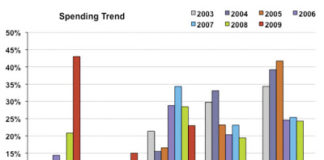Back on June 12, 2007, I noted that the alli marketers applied newspeak principles to direct-to-consumer (DTC) advertising by referring to the drug’s oily spotting side effects as “treatment effects.” (See Alli Newspeak: Oily Spotting is “Treatment Effect”.)
Joe Cadle — official alli marketing director and self-proclaimed “Mr. Marketing Guy” over at the alliConnect blog — argues that “calling them side effects is actually misleading.”
Here’s his “actual” logic:
“Side effects are generally unrelated to what a drug is trying to fix and often are harmful.
“For example, I take a calcium channel blocker to lower my blood pressure. It also makes me dizzy. But I don’t take the channel blocker to get dizzy. If I wanted to get dizzy, I could chase around my 4 kids and 2 dogs.
“When you take alli, the blocked fat goes out the only exit available. If you eat too much fat, the fat excretion is ugly. That’s how the drug works! The exiting fat isn’t a side effect, it’s the actual treatment of the drug. Hence, ‘treatment effects.'”
[See Why’ja call them “treatment effects”?]
Such logic is a good example of what I have often called “carefully wrought marketing BS” (see “Is Pharmaceutical Marketing BS?“), which, unfortunately, may not be easily recognized as such by your average consumer who, I believe, would consider ANY UNWANTED effect of a drug, a side effect. In fact, this is how the Texas Heart Institute defines side effects when describing the calcium channel blockers that Cadle is taking (see here).
I suspect that if alli were an Rx drug rather than an OTC drug, the FDA would NEVER allow Cadle to whitewash side effects as “treatment effects.” Otherwise, marketers of Xenical — the Rx equivalent of alli — would have been using this ploy a long time ago!
In a comment posted to the alliConnect site, I said:
Since Alli is the same chemical entity as prescription drug Xenical — which is required to list side effects by the FDA — we can see that what are called “treatment effects” by Alli marketers are simply called “side effects” in the Xenical label.
See the table of “side effects” in the Xenical label here.
GSK and the alli marketing folks are to be commended for how they are managing the alliConnect blog. They posted my comment without much delay and I have seen several posted comments that are much more negative than mine.
There are also several comments from All team members, who clearly identify themselves as such.
However, you have to balance this against the fact that the blog allows alli marketers to promulgate their marketing BS to a wider audience in pertpetuum without interference from bothersome regulators at FDA who have their heads in the digital sand anyway (see “Where’s DDMAC’s Head At?“).
No Side Effects, No Adverse Events: QED!
Speaking of FDA, Mark Senak over at Eye On FDA comments that pharmaceutical product blogs are so unusual primary because of risk-adverse pharmacovigilence folks within drug companies:
“…some companies have told me that they refuse to monitor blog content for fear of seeing an adverse event reported on their drug which would require pharmacovigilence to step in and investigate. Yet, here is GSK going ahead with a blog that presumably has some spontaneity to it and where comments that are posted can most certainly talk about adverse events.” (See “A Look at GSK’s alli Blog“).
The ability of GSK to do all this is made possible by the lack of FDA regulation in the OTC market. Correct me if I am wrong, there is no need, for example, for OTC manufacturers and marketers to report adverse events to the FDA. There’s even less of a need if there are no side effects, but just “treatment effects.”
One benefit of this ability to allow comments from anyone and to monitor these comments, is the ability for alli marketers to interact with and LEARN from their consumer audience. And there is nothing wrong with that, especially if they keep the dialoque open and honest!









![6 Digital Tools at the Center of Healthcare Digitalization [INFOGRAPHIC]](http://ec2-54-175-84-28.compute-1.amazonaws.com/pharma-mkting.com/wp-content/uploads/2021/04/6DigitalTools_600px-100x70.jpg)




